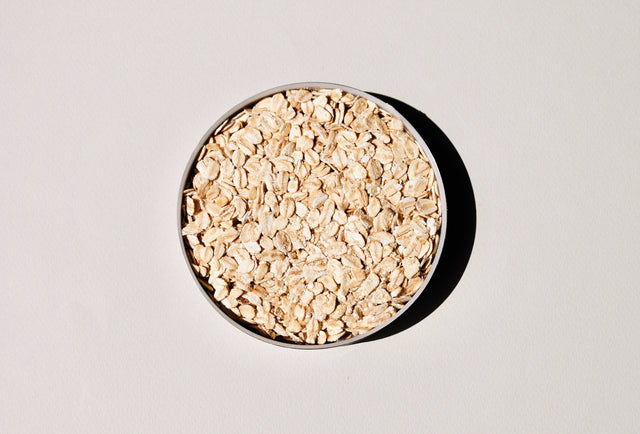Although they have similar names, both glutamine vs glucosamine are very different organic compounds. Glutamine is traditionally used for sports performance, recovery, and digestive health, while glucosamine is used to treat joint pain and improve mobility. We're going to talk about what glutamine and glucosamine do and how they're different.
What Is Glutamine And What Does It Do?
Glutamine is a conditionally essential amino acid. Your body naturally produces nonessential amino acids, however conditional, means that at certain times, when your body is under severe physical stress, it becomes essential to include glutamine rich foods in your diet, or to add a supplement to maintain adequate levels.
RELATED ARTICLE 5 Powerful Benefits Of L-Glutamine
Glutamine has several well-known benefits and roles within the body. Studies have shown that glutamine assists in the building and rebuilding process of the intestinal tract and gut lining, by managing the nitrogen balance in your body [R].This can be extremely beneficial to those with conditions that are defined by intestinal hyperpermeability, such as leaky gut, chrons, ulcerative colitis, and IBS.
RELATED ARTICLE The 5 Best Supplements For Gut Health
Glutamine is also widely used to assist in exercise recovery. Glutamine constructs nearly 60% of the amino acid pool in your muscle tissue. Research indicates that glutamine can inhibit muscle mass breakdown, therefore improving muscle protein synthesis, and reducing exercise induced muscle soreness.
RELATED ARTICLE L Glutamine: The Best Supplement For Post Workout Muscle Recovery
Glutamine Benefits In Summary
- Improve Exercise Recovery
- Reduce Post Workout Muscle Soreness
- Rebuild Gut Lining
- Improve Gut And Digestive Health
What Is Glucosamine And What Does It Do?
Glucosamine is a compound found naturally in the body, made from fructose and the amino acid glutamine. Glucosamine is needed to produce glycosaminoglycan, a molecule used in the formation and repair of cartilage and other body tissues. Glycosaminoglycans are key contributors to specific cartilage properties such as elasticity, strength, and flexibility [R]. Glucosamine is found between the joints, providing padding and cushion.
Glucosamine supplements are widely used in the treatment of osteoarthritis and to assist in joint health. Osteoarthritis affects over 240 million people worldwide and is a progressive condition most frequently affecting the larger weight-bearing joints of the body.
Many glucosamine supplements combine glucosamine with other ingredients, such as chondroitin sulfate or methylsulfonylmethane, known as MSM. There is some evidence that glucosamine supplements may help slow the aging process of cartilage as it becomes less flexible and starts to breakdown, yet there is not enough scientific evidence to confirm this claim.
A systematic review states that although in vitro studies have demonstrated that glucosamine significantly downregulates and upregulates catabolic and anabolic processes, human clinical trials have failed to demonstrate these effects in vivo effectively [R]. Another review published in the journal Orthopedics, suggests the benefits of glucosamine are due to placebo effect [R].
Glucosamine Benefits In Summary
- May Improve Joint Health
- May Help Osteoarthritis
Glutamine Vs Glucosamine Differences
It’s apparent that glutamine is very different than glucosamine, in several fundamental ways. Glucosamine is a naturally occurring sugar found around your joints and ligaments, while Glutamine is a conditionally essential amino acid, providing fuel for your gastrointestinal tract, particularly the cells which line your small intestine. Glucosamine has little to no significant evidence which shows it works to help joint pain or reduce symptoms of osteoarthritis. Glutamine is used for sports performance to help with recovery and muscle soreness. Extensive research has also shown that glutamine improves immune health and rebuilds gut lining, improving digestive health.
Unlike Glutamine, glucosamine cannot be derived from dietary sources, and has to be supplemented. Glutamine is found in several different foods, mostly protein such as chicken, beef, tuna, salmon and whey protein isolate.
Glutamine Vs Glucosamine Frequently Asked Questions
What Can I Take Instead Of Glucosamine
Research suggests that evidence is lacking to support glutamine as well as chondroitin, for joint health. However several studies have shown that Omega-3 supplements, specifically Krill Oil, as well as Collagen can help reduce joint pain, and improve symptoms of osteoarthritis [R, R].
Can You Take Glutamine And Glucosamine Together
Yes, you can take glutamine and glucosamine together if you are experiencing prolonged post workout muscle soreness, as well as joint pain, digestive issues, etc. Each supplement can be taken and do not have any contraindications when together.
Glutamine Vs Glucosamine: Takeaway
Evidence suggests that glutamine can benefit digestive health, optimize workout recovery, and improve immune health. Inflammatory bowel disease such as chrons, leaky gut, and ulcerative colitis are characterized by intestinal hyperpermeability. Glutamine has been shown to help rebuild your gut lining and fuel the small intestine to reduce gut hyperpermeability, and improve overall health and wellness. If you’re looking for a joint supplement to help with joint pain, take krill oil or collagen instead. Although various studies have attempted to evaluate the effectiveness of glucosamine sulfate as a therapeutic agent in the treatment of Osteoarthritis and joint health, human clinical trials have failed to show a significant effect as a therapeutic agent.
SWOLVERINE is an endurance athlete and active lifestyle brand. Made for the elite athlete, and the strong-willed our products were designed to fuel your athletic performance. We perform when you perform.
We believe that everyone can optimize not only their athletic performance but their human potential. The way we believe we can optimize performance is through transparency, clinically effective doses, and clinically proven ingredients with evidence-based outcomes. We provide the nutrients you need to power your active lifestyle.
References
Kim, Min-Hyun, and Hyeyoung Kim. “The Roles of Glutamine in the Intestine and Its Implication in Intestinal Diseases.” International journal of molecular sciences vol. 18,5 1051. 12 May. 2017, doi:10.3390/ijms18051051
Williams C, Ampat G. Glucosamine Sulfate. [Updated 2021 Jan 29]. In: StatPearls [Internet]. Treasure Island (FL): StatPearls Publishing; 2021 Jan-. Available from: https://www.ncbi.nlm.nih.gov/books/NBK558930/#
Clark KL, Sebastianelli W, Flechsenhar KR, Aukermann DF, Meza F, Millard RL, Deitch JR, Sherbondy PS, Albert A. 24-Week study on the use of collagen hydrolysate as a dietary supplement in athletes with activity-related joint pain. Curr Med Res Opin. 2008 May;24(5):1485-96. doi: 10.1185/030079908x291967. Epub 2008 Apr 15. PMID: 18416885.
Maroon JC, Bost JW. Omega-3 fatty acids (fish oil) as an anti-inflammatory: an alternative to nonsteroidal anti-inflammatory drugs for discogenic pain. Surg Neurol. 2006 Apr;65(4):326-31. doi: 10.1016/j.surneu.2005.10.023. PMID: 16531187.








